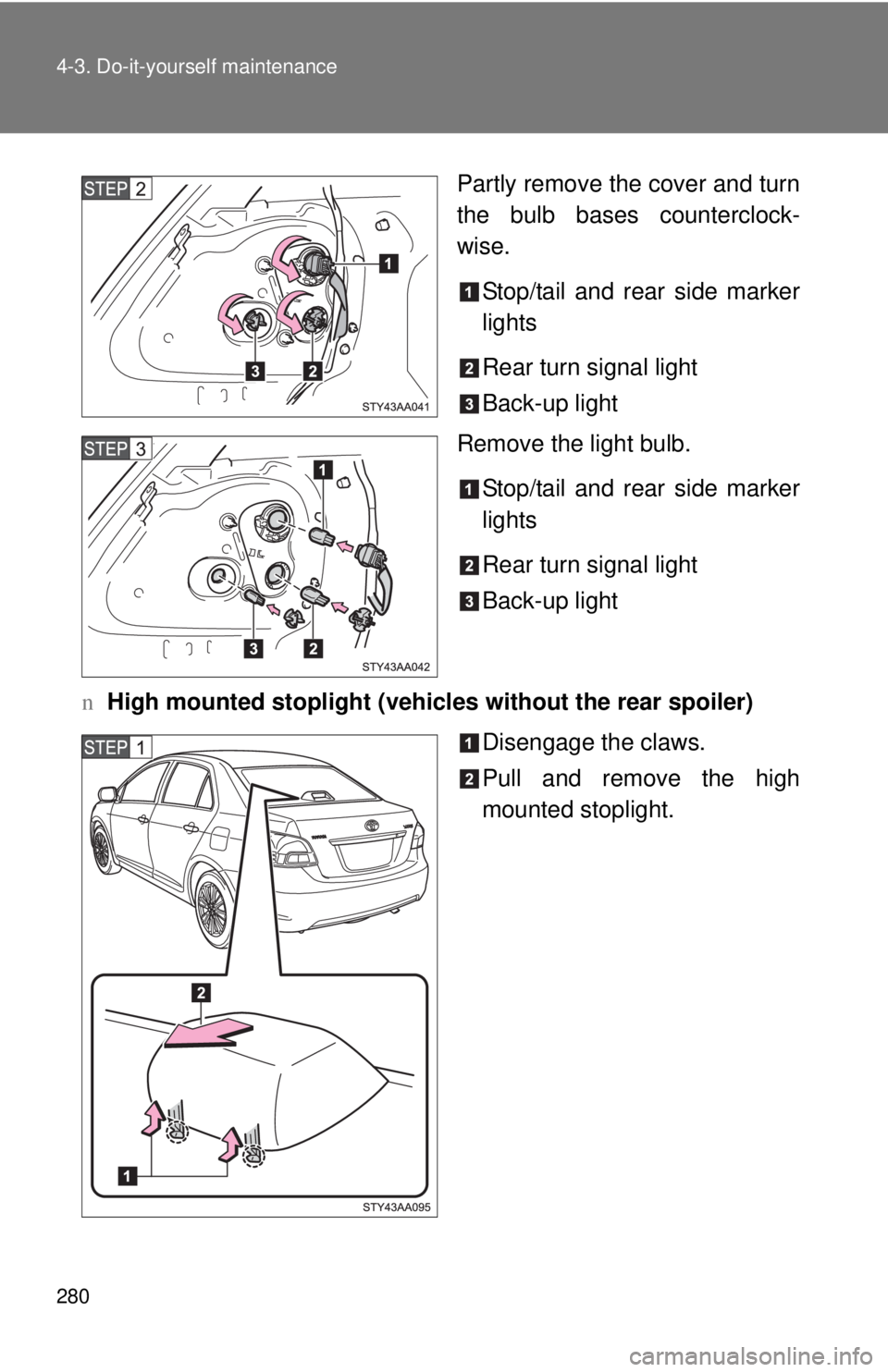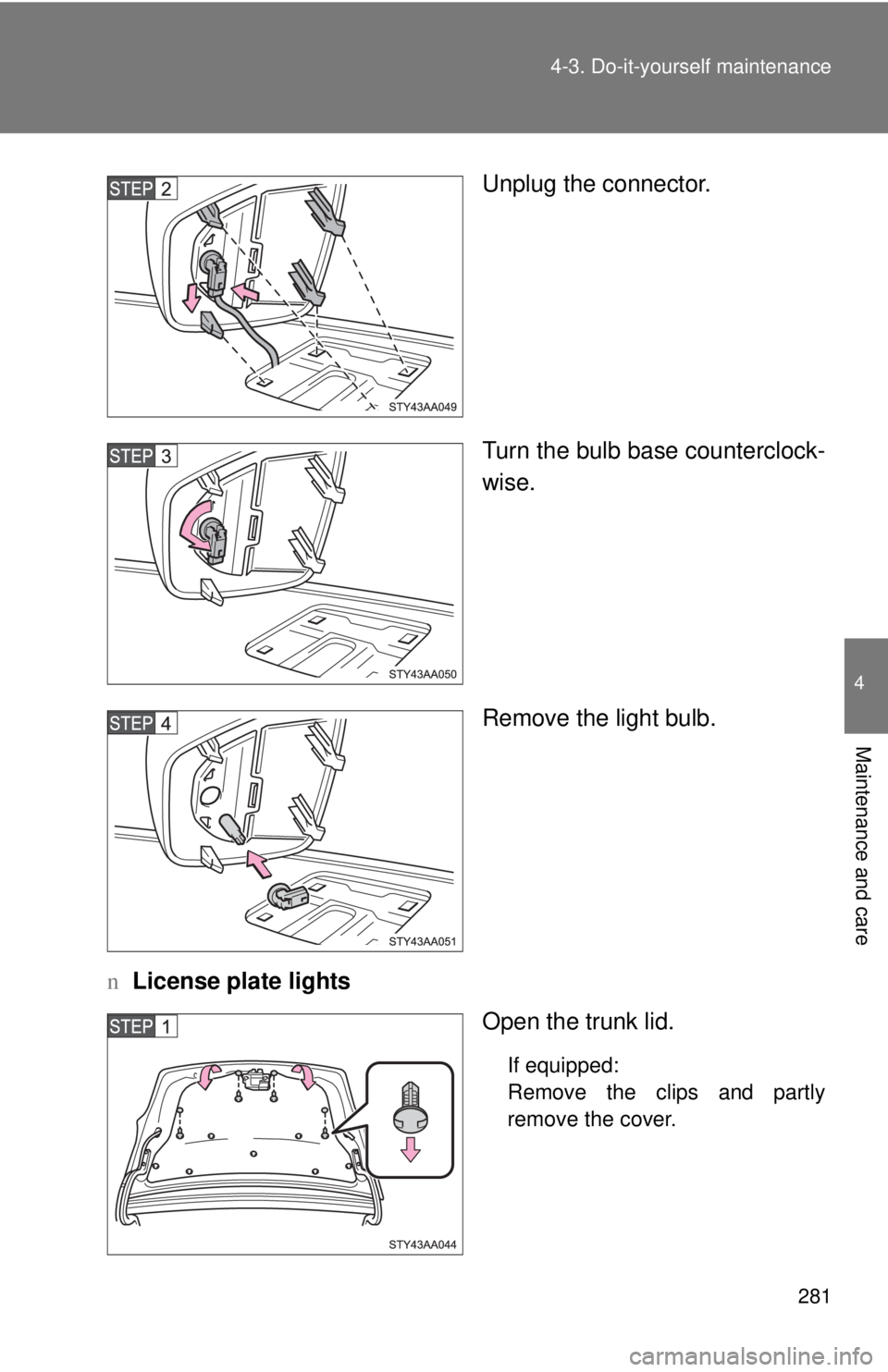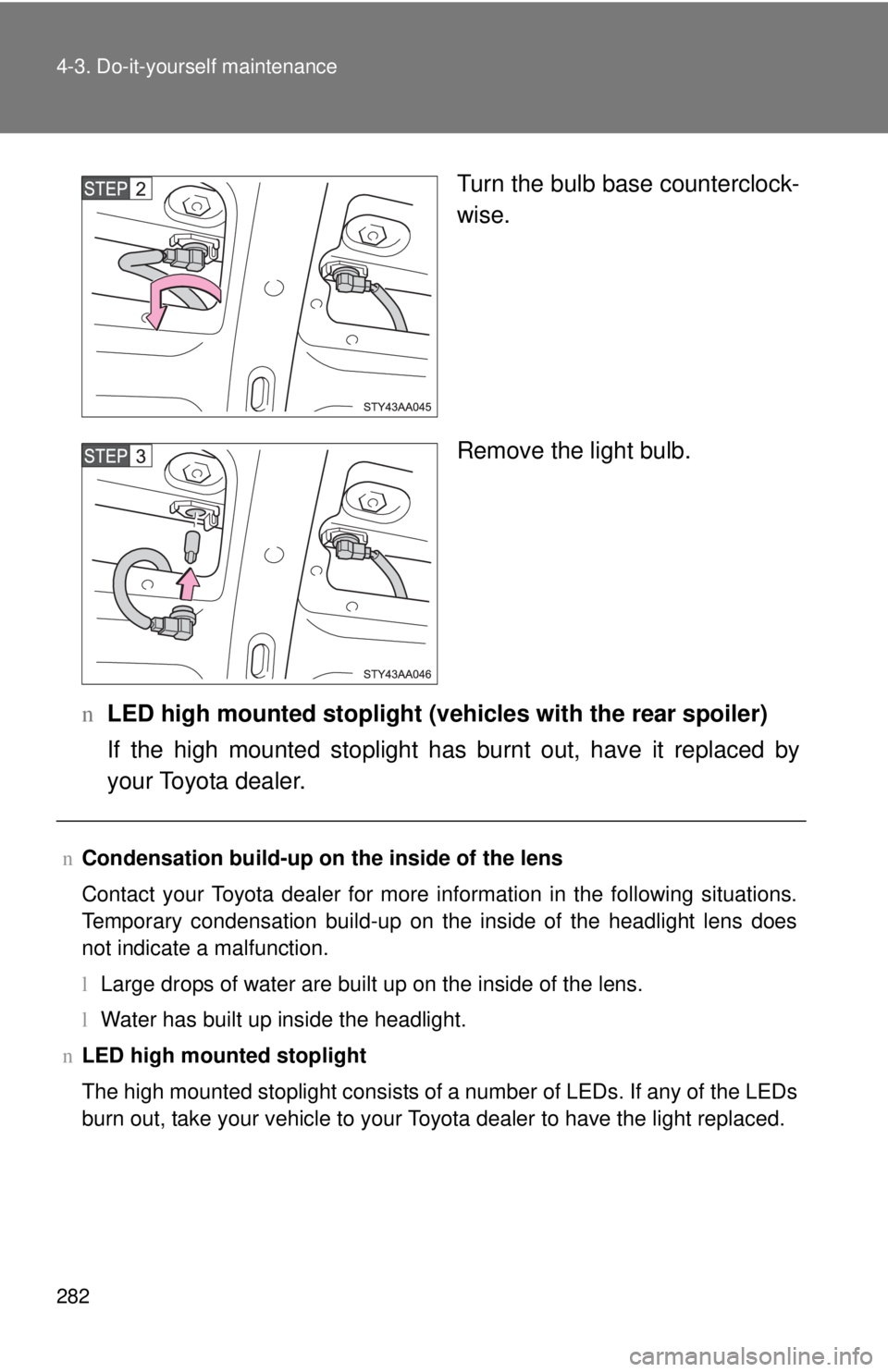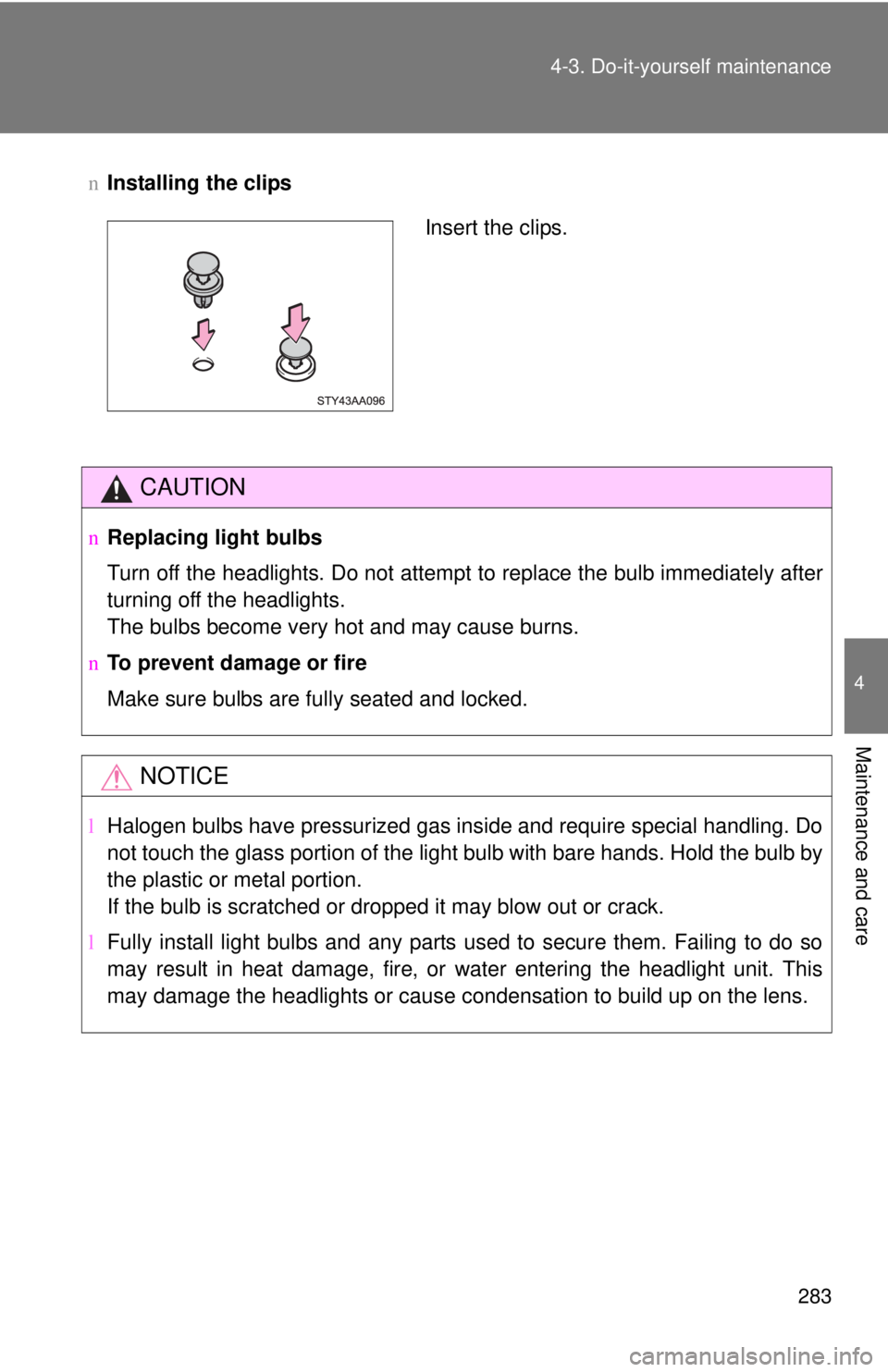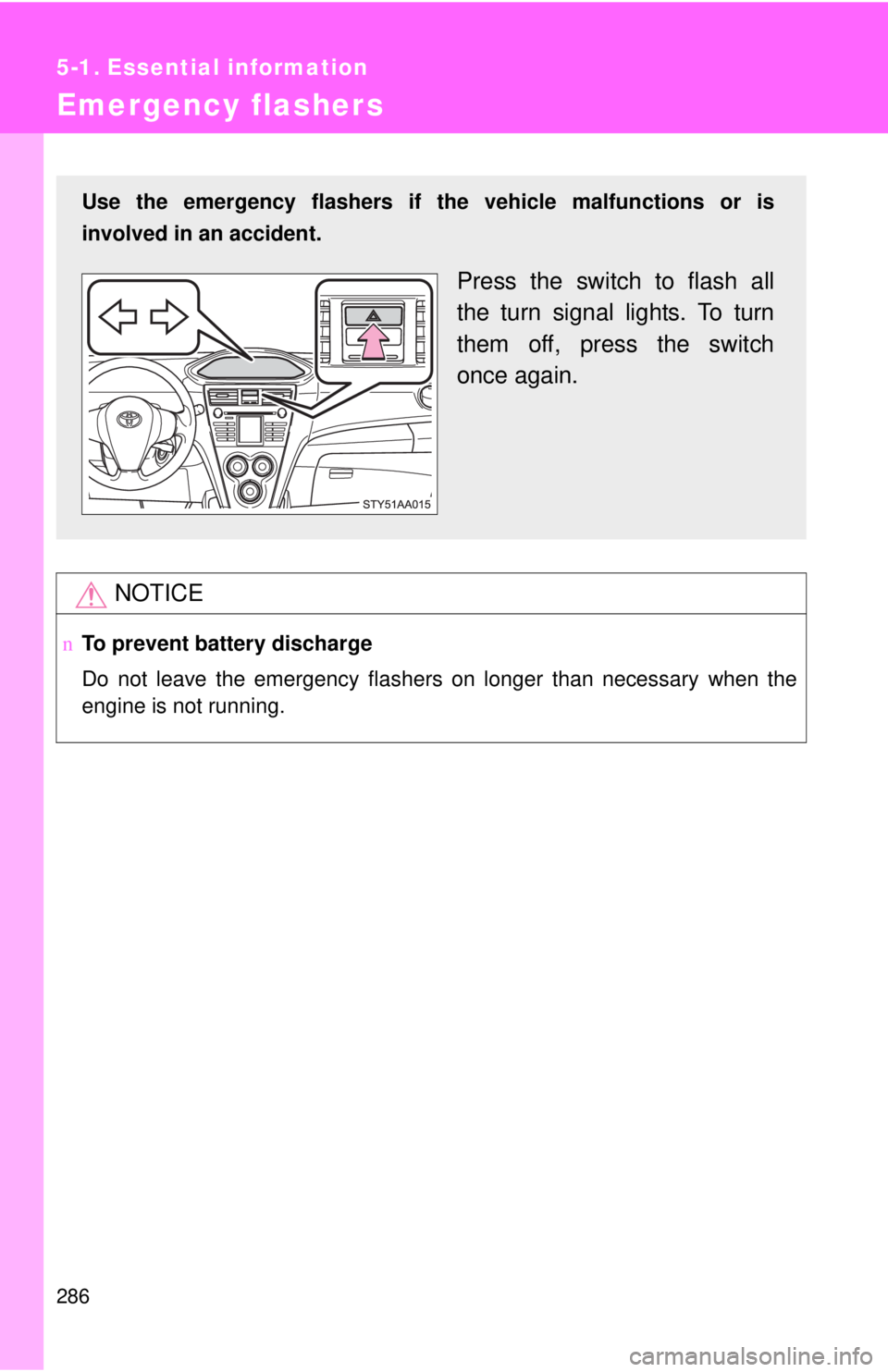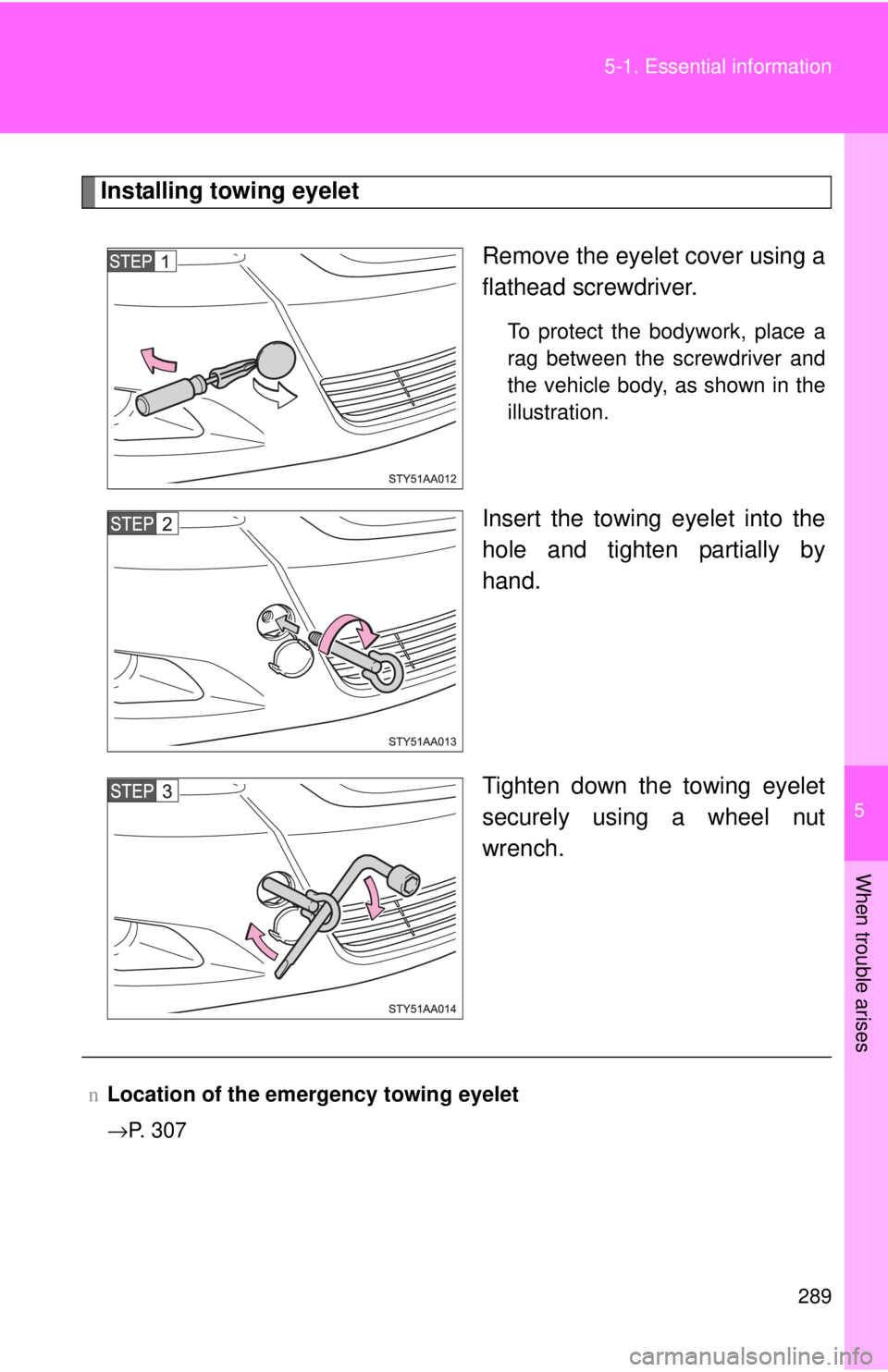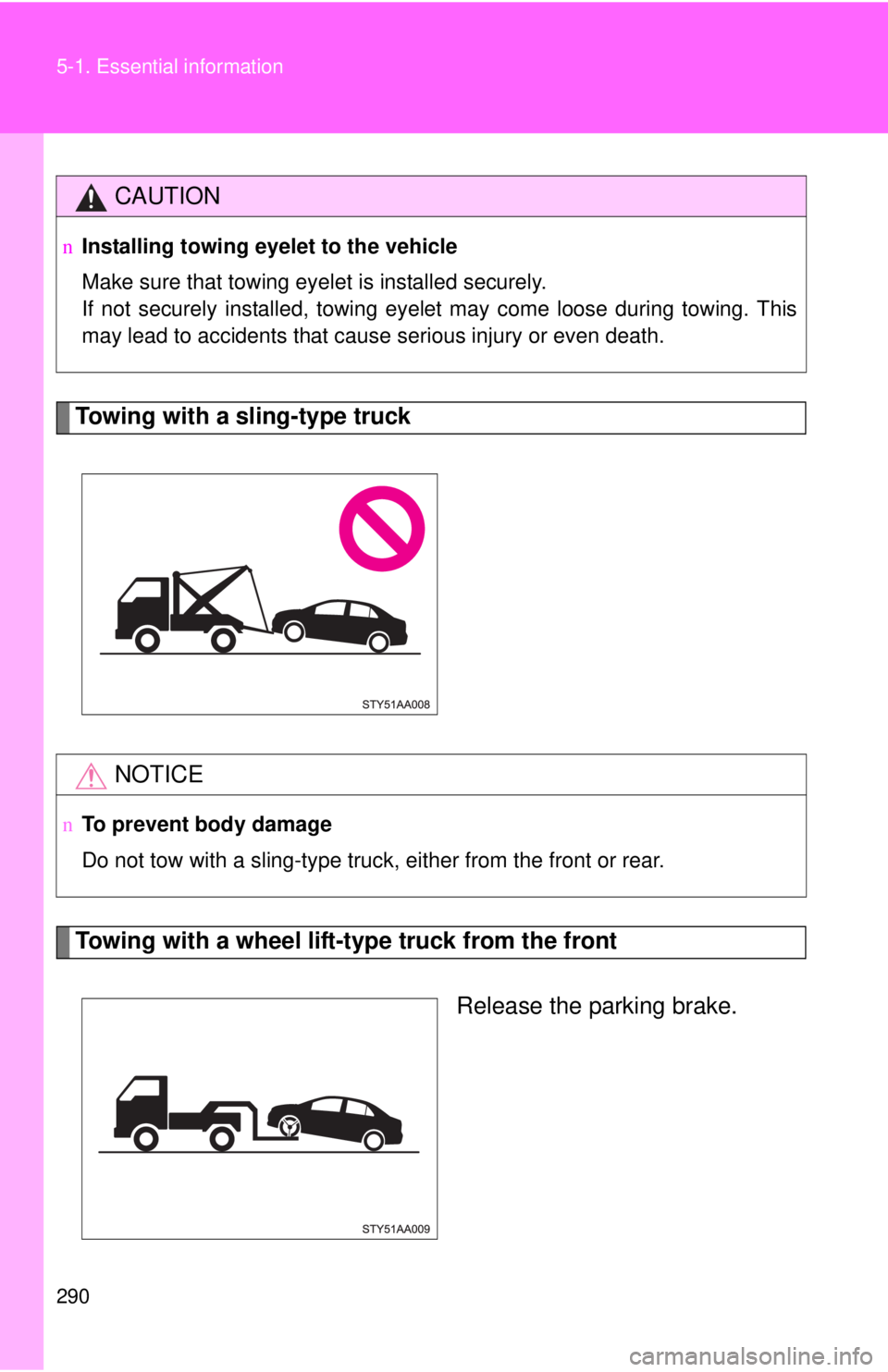TOYOTA YARIS SEDAN 2010 Owners Manual
YARIS SEDAN 2010
TOYOTA
TOYOTA
https://www.carmanualsonline.info/img/14/59282/w960_59282-0.png
TOYOTA YARIS SEDAN 2010 Owners Manual
Trending: warning lights, radio controls, fuel pressure, 1nz, clock, maintenance, tow
Page 291 of 386
280 4-3. Do-it-yourself maintenance
Partly remove the cover and turn
the bulb bases counterclock-
wise.Stop/tail and rear side marker
lights
Rear turn signal light
Back-up light
Remove the light bulb.
Stop/tail and rear side marker
lights
Rear turn signal light
Back-up light
n High mounted stoplight (vehicle s without the rear spoiler)
Disengage the claws.
Pull and remove the high
mounted stoplight.
Page 292 of 386
281
4-3. Do-it-yourself maintenance
4
Maintenance and care
Unplug the connector.
Turn the bulb base counterclock-
wise.
Remove the light bulb.
n License plate lights
Open the trunk lid.
If equipped:
Remove the clips and partly
remove the cover.
Page 293 of 386
282 4-3. Do-it-yourself maintenance
Turn the bulb base counterclock-
wise.
Remove the light bulb.
n LED high mounted stoplight (veh icles with the rear spoiler)
If the high mounted stoplight has burnt out, have it replaced by
your Toyota dealer.
n Condensation build-up on th e inside of the lens
Contact your Toyota dealer for more information in the following situations.
Temporary condensation build-up on the inside of the headlight lens does
not indicate a malfunction.
l Large drops of water are built up on the inside of the lens.
l Water has built up inside the headlight.
n LED high mounted stoplight
The high mounted stoplight consists of a number of LEDs. If any of the LEDs
burn out, take your vehicle to your Toyota dealer to have the light replaced.
Page 294 of 386
283
4-3. Do-it-yourself maintenance
4
Maintenance and care
n
Installing the clips
CAUTION
nReplacing light bulbs
Turn off the headlights. Do not attempt to replace the bulb immediately after
turning off the headlights.
The bulbs become very hot and may cause burns.
n To prevent damage or fire
Make sure bulbs are fully seated and locked.
NOTICE
lHalogen bulbs have pressurized gas inside and require special handling. \
Do
not touch the glass portion of the light bulb with bare hands. Hold the bulb by
the plastic or metal portion.
If the bulb is scratched or dropped it may blow out or crack.
l Fully install light bulbs and any parts used to secure them. Failing to do so
may result in heat damage, fire, or water entering the headlight unit. This
may damage the headlights or cause condensation to build up on the lens.
Insert the clips.
Page 295 of 386
284 4-3. Do-it-yourself maintenance
Page 296 of 386
286
5-1. Essential information
Emergency flashers
NOTICE
nTo prevent battery discharge
Do not leave the emergency flashers on longer than necessary when the
engine is not running.
Use the emergency flashers if th e vehicle malfunctions or is
involved in an accident.
Press the switch to flash all
the turn signal lights. To turn
them off, press the switch
once again.
Page 297 of 386
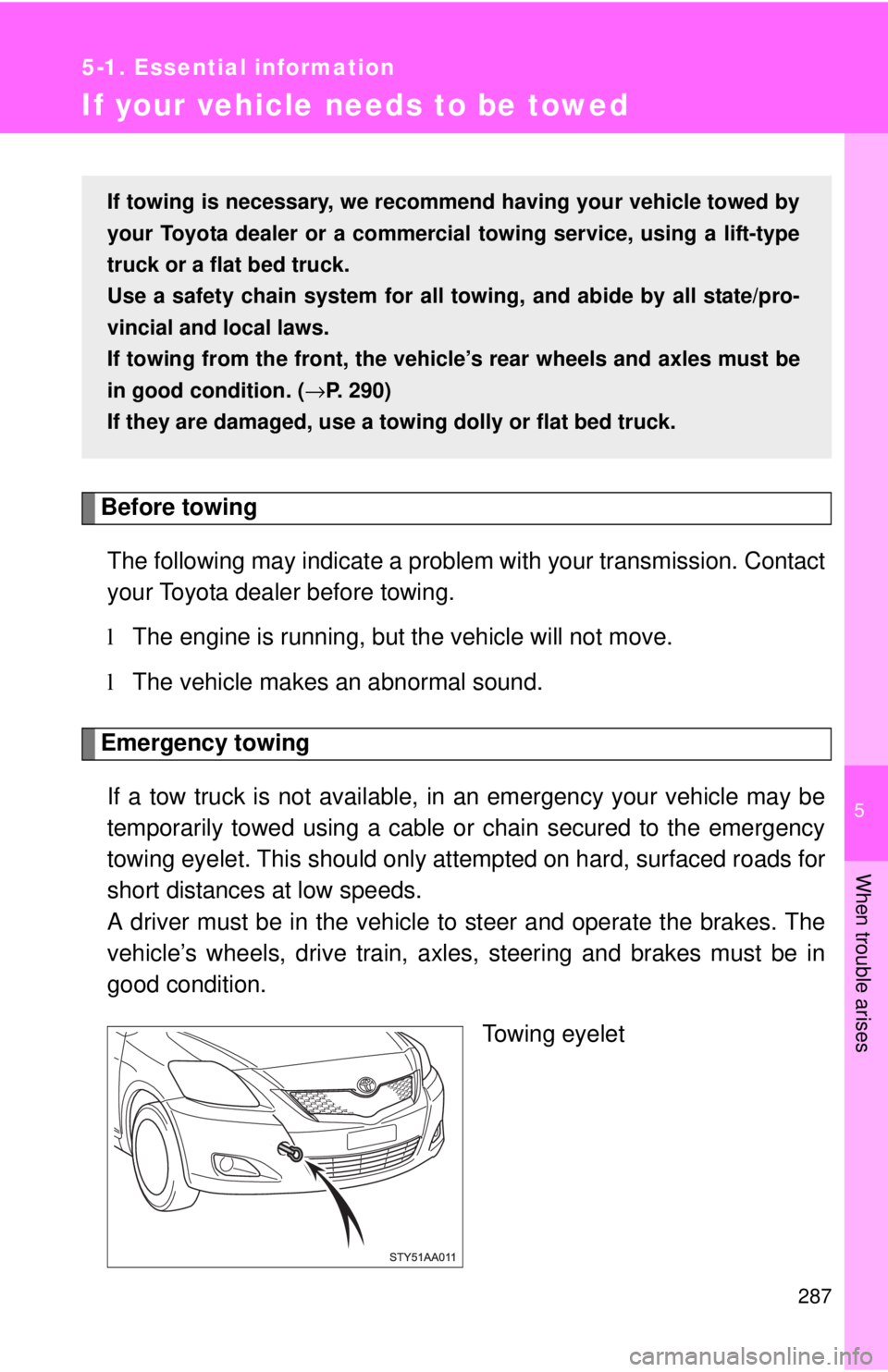
5
When trouble arises
287
5-1. Essential information
If your vehicle needs to be towed
Before towingThe following may indicate a problem with your transmission. Contact
your Toyota dealer before towing.
l The engine is running, but the vehicle will not move.
l The vehicle makes an abnormal sound.
Emergency towing
If a tow truck is not available, in an emergency your vehicle may be
temporarily towed using a cable or chain secured to the emergency
towing eyelet. This should only attempted on hard, surfaced roads for
short distances at low speeds.
A driver must be in the vehicle to steer and operate the brakes. The
vehicle’s wheels, drive train, axles, steering and brakes must be in
good condition.
Towing eyelet
If towing is necessary, we recommend having your vehicle towed by
your Toyota dealer or a commerci al towing service, using a lift-type
truck or a flat bed truck.
Use a safety chain system for all to wing, and abide by all state/pro-
vincial and local laws.
If towing from the front, the vehic le’s rear wheels and axles must be
in good condition. (→P. 290)
If they are damaged, use a towing dolly or flat bed truck.
Page 298 of 386
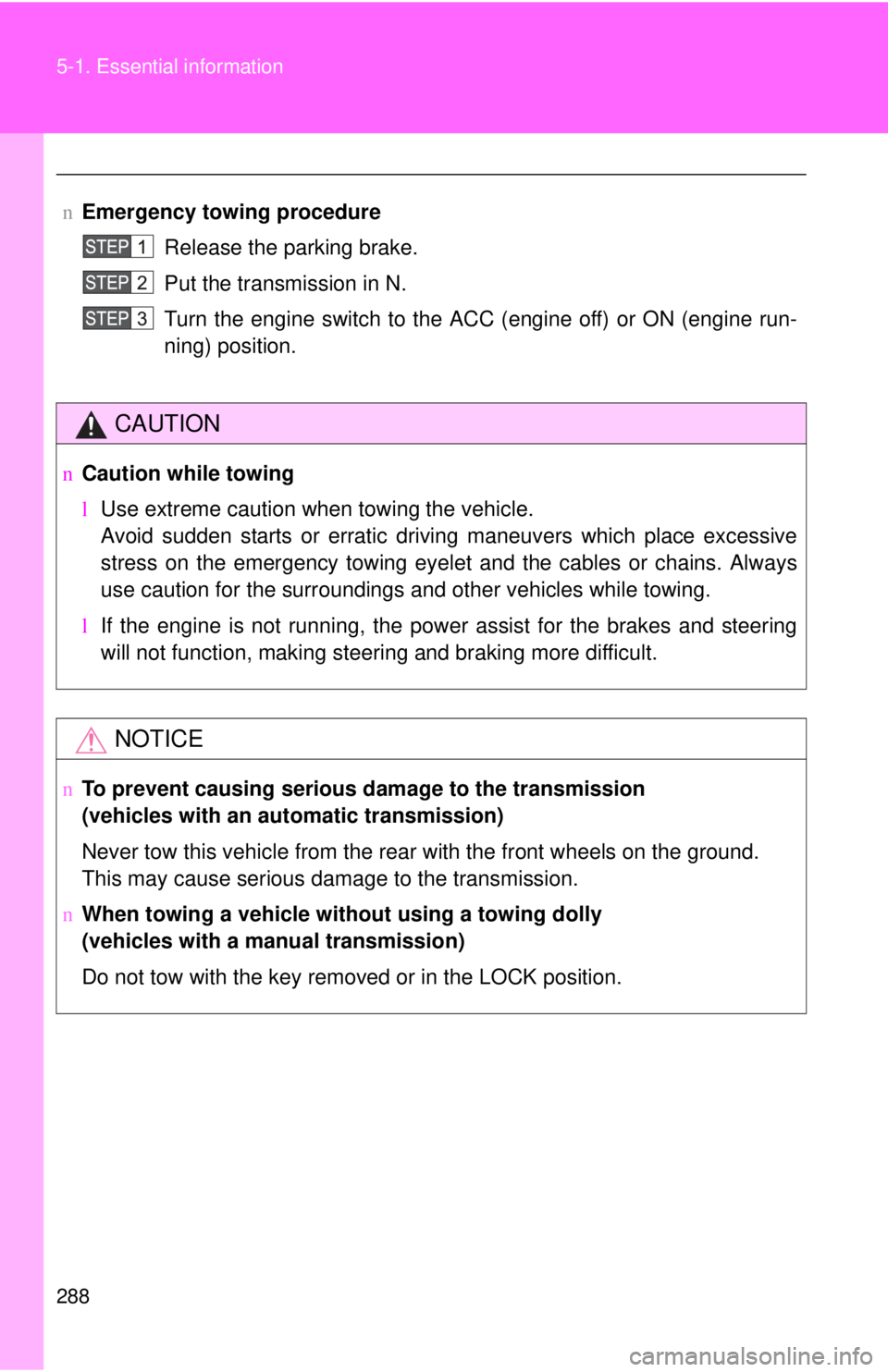
288 5-1. Essential information
nEmergency towin g procedure
Release the parking brake.
Put the transmission in N.
Turn the engine switch to the ACC (engine off) or ON (engine run-
ning) position.
CAUTION
n Caution while towing
lUse extreme caution when towing the vehicle.
Avoid sudden starts or erratic driving maneuvers which place excessive
stress on the emergency towing eyelet and the cables or chains. Always
use caution for the surroundings and other vehicles while towing.
l If the engine is not running, the power assist for the brakes and steering
will not function, making steering and braking more difficult.
NOTICE
nTo prevent causing serious dama ge to the transmission
(vehicles with an automatic transmission)
Never tow this vehicle from the rear with the front wheels on the ground.
This may cause serious damage to the transmission.
n When towing a vehicle without using a towing dolly
(vehicles with a manual transmission)
Do not tow with the key removed or in the LOCK position.
Page 299 of 386
5
When trouble arises
289
5-1. Essential information
Installing towing eyelet
Remove the eyelet cover using a
flathead screwdriver.
To protect the bodywork, place a
rag between the screwdriver and
the vehicle body, as shown in the
illustration.
Insert the towing eyelet into the
hole and tighten partially by
hand.
Tighten down the towing eyelet
securely using a wheel nut
wrench.
nLocation of the emer gency towing eyelet
→P. 307
Page 300 of 386
290 5-1. Essential information
Towing with a sling-type truck
Towing with a wheel lift-type truck from the frontRelease the parking brake.
CAUTION
nInstalling towing eyelet to the vehicle
Make sure that towing eyelet is installed securely.
If not securely installed, towing eyelet may come loose during towing. This
may lead to accidents that cause serious injury or even death.
NOTICE
nTo prevent body damage
Do not tow with a sling-type truck, either from the front or rear.
Trending: spare wheel, four wheel drive, oil dipstick, open gas tank, tire type, manual transmission, battery location
